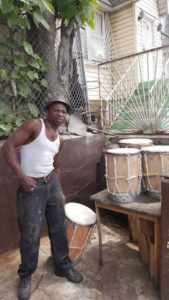Garifuna Musical Instruments
Haga Clic Para Leer En Español
Garifuna musical instruments are quite basic. These traditionally consist of drums, maracas and, more recently, the guitar and the turtle shells.
The drums are the primary musical instruments of the Garifuna and these are used for sacred as well as secular purposes. The drums are normally made out of hollowed sections of tree trunks with antelope skin stretched tightly across one end and held in place by rope that can be stretched to tighten the instrument by means of wooden pins. Garifuna drums were typically imported from central America, however, Mr. Victor Garcia manufactures high quality drums in the Bronx, New York.
Two drums are normally used for secular music. These typically consist of a base drum that is usually the larger of the two and provides the basic rhythm. This drum is called the segunda. The smaller drum provides the embellishments and normally require a greater level of skill on the part of the drummer who in certain of the dances may have to improvise in order to rise to the demands of the dancer in dances like the wanaragua, the chumba and the sambai. This smaller drum is called the primero.
There is a third type of drum. This is generally larger than the segunda and reserved for use in sacred music associated with rituals like the dügü. Three such drums are played at the same time with the one in the center, called the lanigi Garawoun (the heart of the drum) taking the lead.
The Maracas
The maracas are rattles that are played in pairs. To make these the insides of two whole calabashes are extracted and replaced with the mature seeds of a plant called weinwein. A stick to be used as a handle is then forced through holes that had been made at the top and the bottom of each of the gourds.
The maracas are used for certain types of secular and sacred music but there are other types with which they are never associated.
These rattles may also have religious significance in that each buyei (Garifuna spiritual leader) invariably has at least one pair of large rattles that can be seen as a badge of his or her office. This maraga, as it is called, is used by the buyei in healing ceremonies like the dügü or the chugü.
The Guitar
It is perhaps safe to assume that the acoustic guitar was borrowed into Garifuna music after the exile to Central America some time during the last two hundred years. It is here that Hispanic influence manifests itself in Garifuna music. The association of the guitar with traditional Garifuna music is limited to the paranda, a name which itself is obviously of Spanish origin. More recently, with the emergence of Punta Rock, the guitar has joined other modern instruments as Garifuna lyrics and rhythms were repackaged for wider national, regional and international consumption.
Conch Shell
The conch shell trumpet is the only wind instrument used today in Garifuna traditional music. Because this instrument was commonly employed by Native Americans and may have also been used among West Africans, the exact origin and date of its initial use among the Garifuna is unknown. The shell is of course the housing or casing for conch from which fritters and soup are made. These seasonal delicacies are popular in many coastal Garifuna communities as well as in other locations throughout the circum-Caribbean region. The shell is made into a wind instrument when the pointed spiral top is cut off and air is blown through the aperture with the lips. The closed, buzzing-lip embouchure used in playing orchestral brass instruments is also used to create sound through the conch shell. A single tone is usually played on each shell, with the relative highness or lowness of the pitch determined by the size of the shell. For example, smaller shells produce higher pitches than the large shells. Though higher pitches can be produced when air is forced though more tightly held lips, they are rarely performed. Single tones played in repetitive patterns are most commonly heard in acoustic performances of traditional puntas. Usually, the instrument is played only sporadically during the performance of a song.
The Turtle Shells
Minor instruments like conch shells, cow bells, and the mouth organ have long had a peripheral place in traditional Garifuna music as there was always the need for improvisation and adaptability as our musicians strived to meet the musical needs of the community. What is perhaps ironic is that it was in responding to the need to improvise that the turtle shells found their way into Garifuna music in Pen Cayetano’s art studio at Moho Street in Dangriga in 1978 and it can be said that it was that happy accident that gave rise to the Turtle Shell Band and brought about the latest development in Garifuna music in the form of Punta Rock.
With the advent of punta rock, Garifuna incorporated the electric guitar and later the electric bass to ensembles of indigenous instruments. The electric guitars in punta rock bands usually provide harmonic and secondary rhythmic support in the form of repetitive chord progressions, like rhythmic guitars in rock, rhythm and blues, and some popular Caribbean song forms. In punta rock songs, the electric bass provides an additional harmonic foundation as with other forms of popular commercial music.














Follow Us